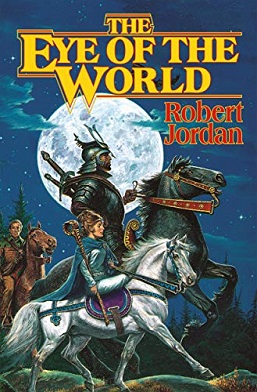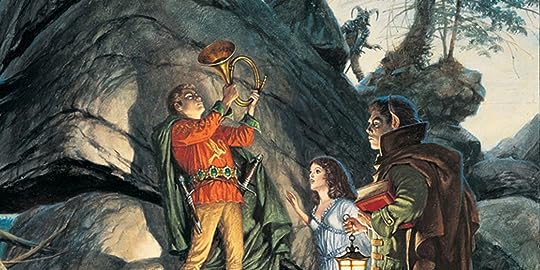“The Wheel of Time turns, and ages come and pass, leaving memories that become legend. Legend fades to myth, and even myth is long forgotten when the Age that gave it birth comes again. In one Age, called the Third Age by some, an Age yet to come, an Age long past, a wind rose in the Mountains of Mist. The wind was not the beginning. There are neither beginnings nor endings to the turning of the Wheel of time. But it was a beginning.”
― Robert Jordan, The Eye of the World
So begins Robert Jordan’s fourteen-book, 4.4 million word saga, The Wheel of Time, a tale which has sold over ninety million copies since the first novel in the series was published in 1990.
Some three decades ago, or an age ago, in Wheel terms, when I was in high school and college, I happily devoured the first four books in Robert Jordan’s high fantasy series. It hit me at exactly the right time; I had recently read The Lord of the Rings and was constantly on the lookout for more epic fantasy. Jordan’s story fit the bill, and I enjoyed every minute I spent in his world.
As the series went on, I became disappointed with the next two or three books and eventually gave up on them. For me, what started out as an excellent fantasy adventure tale that was heading in a satisfying, if not entirely original direction became bogged down with an unwieldy plot and too many characters. Each new installment of the series introduced more plot elements, settings and people until I stopped seeing the heroes like Rand, Moiraine, Perrin, Egwene, Matt and the rest of the cast of characters that had started out on such a promising adventure in The Eye of the World.
My friends who were fantasy aficionados felt the same way. By the time the later installments of the books came out, I had moved on and lost interest. There were always plenty of other books to read, and other fantasy worlds to explore by writers like Tad Williams, Ursula LeGuin, and many others I was busy discovering. When new Jordan books arrived, I was interested in them but not tempted enough to buy and read them. I’d already spent thousands of pages with The Wheel of Time, and it seemed there was no end in sight.
When I saw that amazon was adapting the Wheel of Time, I thought it might be a good chance for them to tighten up this story a bit, maybe streamline things and tell a rousing tale. I watched season one with great hope but did not really enjoy it. However, I did go back to read The Eye of the World and The Great Hunt, books one and two of the series.
I’m happy to say that after thirty years, these first two installments hold up well. I had forgotten most of the plot over three decades, but I very much enjoyed Jordan’s setup in the Shire-like Two Rivers, the flight from the Myrddraal and the Trollocs, and the slow unveiling of the truth of Rand’s destiny. The magic system is well developed: female wizards wield a magical force called The One Power and must train for years to do it. The philosophical underpinnings of the Wheel, where the world is in a continuous cycle of history, were a fun innovation for the fantasy genre that gave the setting plenty of depth, to my mind.
For me, some of this story aged less well, specifically the adolescent romantic longings of the main characters. I guess I was ok with this kind of thing when I was a teen and in my early twenties, but such doe-eyed yearning was not exactly to my taste this time around. But I let it go, because the story is fun and engaging enough to keep me interested.
What I also found striking in my re-read was the all-female wizardry of the Aes Sedai. They are a powerful order, akin to the Bene Gesserit of Dune. The political maneuverings of their different classes allow for plenty of intrigue and some great plot twists. The idea that men have tainted the One Power is also reminiscent of LeGuin’s Earthsea books.
I could do with less of Jordan’s at times florid descriptions of how gorgeous and powerful some of these women are, though–he lays it on thick at times. In The Great Hunt there is a sequence where some evil women of the Seanchan, an invading army, have leashed and enslaved Aes Sedai and other women who can wield the One Power. I’m not sure the story needed this sadistic plot point, but I guess Jordan had his reasons.
Clearly, plenty of readers disagree with my criticisms, and loved the entire cycle, including the final three books, finished posthumously by the amazingly prolific Brandon Sanderson. It’s sad that Jordan didn’t live to finish the series, but it seems he had a good steward to bring to to its conclusion.
I enjoyed re-reading these two books very much, partly for nostalgia’s sake, but also because they’re a lot of fun. The Great Hunt has a particularly stirring climax, where Rand and his friends face impossible odds as they pursue an ancient, magical horn that will call back legendary heroes of a past age. There are some engaging action sequences with high stakes for everyone involved. Rand, who now knows he is The Dragon Reborn, the great hero on which the hope of the world rests, must fight a demonic being to save his friends. The different creatures and races in the book are also quite well described and evocative. Some of the nightmarish dream sequences, in which Rand and his friends face their darkest fears, brought on by the evil beings that are hunting them down, are well told and gripping. Like Herbert and Tolkien, Jordan took a lot of care in creating these alien societies, and they’re quite detailed and consistent. Jordan had a lot of panache in telling these stories, and it’s easy to see why so many fans stuck with him. Maybe I’ll make it all the way through to the end, this time.
It does seem clear by the end of book two, though, the direction in which this story is moving, so I’m unsure why this series could not have reached a perfectly satisfying conclusion in three or four books. That’s just one reader’s opinion, and others have felt differently, but with so many other good books to read, I can’t say with certainty that I’ll read the other twelve books in this series. Maybe this summer I’ll dive back in for The Dragon Reborn.
















